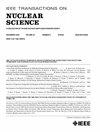Development of Radiation-Tolerant Slow-Control Board Based on Atom Switch-Based FPGA
IF 1.9
3区 工程技术
Q3 ENGINEERING, ELECTRICAL & ELECTRONIC
引用次数: 0
Abstract
The atom switch-based FPGA (AS-FPGA) is a promising candidate for high-radiation environments, such as those encountered in future particle physics experiments using accelerators. To assess its feasibility, we conducted neutron and gamma-ray irradiation tests. No single-event upsets (SEUs) were detected at least up to基于原子开关 FPGA 的耐辐射慢速控制板的开发
基于原子开关的 FPGA(AS-FPGA)是高辐照环境(如未来使用加速器的粒子物理实验中遇到的环境)的理想候选器件。为了评估其可行性,我们进行了中子和伽马射线辐照测试。在分别施加和不施加电压的情况下,至少在 10^{11}$ n/cm2 和 10^{12}$ n/cm2 的范围内没有检测到单次事件破坏(SEU)。AS-场可编程门阵列(FPGA)至少能承受高达 10^{14}$ n/cm2 的位移损伤剂量(DDD)水平,并且在有外加电压和无外加电压的情况下,至少在 5 kGy 和 10 kGy 的范围内没有总电离剂量(TID)效应。这些结果证实了它适用于高辐射环境。为了便于实际应用,我们开发了一个评估板来研究其功能和性能。我们制作了一个集成了商用慢控传感器的慢控板原型。该原型用于实现温度数据采集的基本逻辑,并在中子辐照下进行了测试。慢速控制板在高达 10^{11}$ n/cm2 的高辐照环境下成功运行,证明了 AS-FPGA 和慢速控制板在未来粒子物理实验中的潜力。
本文章由计算机程序翻译,如有差异,请以英文原文为准。
求助全文
约1分钟内获得全文
求助全文
来源期刊

IEEE Transactions on Nuclear Science
工程技术-工程:电子与电气
CiteScore
3.70
自引率
27.80%
发文量
314
审稿时长
6.2 months
期刊介绍:
The IEEE Transactions on Nuclear Science is a publication of the IEEE Nuclear and Plasma Sciences Society. It is viewed as the primary source of technical information in many of the areas it covers. As judged by JCR impact factor, TNS consistently ranks in the top five journals in the category of Nuclear Science & Technology. It has one of the higher immediacy indices, indicating that the information it publishes is viewed as timely, and has a relatively long citation half-life, indicating that the published information also is viewed as valuable for a number of years.
The IEEE Transactions on Nuclear Science is published bimonthly. Its scope includes all aspects of the theory and application of nuclear science and engineering. It focuses on instrumentation for the detection and measurement of ionizing radiation; particle accelerators and their controls; nuclear medicine and its application; effects of radiation on materials, components, and systems; reactor instrumentation and controls; and measurement of radiation in space.
 求助内容:
求助内容: 应助结果提醒方式:
应助结果提醒方式:


